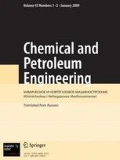The present study is devoted to evaluating the influence of the number of technical inspection cycles on the remaining life of gas cylinders with different methods of cleaning of the inner surface of the equipment and with different compositions of the corrosive media. The thickness of the wall of the cylindrical part, floor, and neck of a gas cylinder is calculated as a function of the number of cycles of technical inspection, employing different methods of cleaning the internal surface of the cylinder, including mechanical treatment with chains, shot blasting, and a pulsating flow of shot in a fluidized bed. The reduction in the thickness of the wall of the vessel is analyzed in the course of corrosive and erosive action of different working media and it is found that the cylindrical part of the cylinder is the zone that is the most susceptible to damage. Treatment with a pulsating flow of shot in a fluidized bed during technical diagnostics makes it possible to realize more uniform removal of the surface layer of metal throughout the internal volume of the gas cylinder as compared to conventional shot blasting and, ultimately, to reduce internal stresses in the material and increase the life of the vessel. Where condensate is present, the greatest damage is found in the bottom and lower cylindrical part of cylinders used to store nitrogen and carbon dioxide.




Similar content being viewed by others
References
Federal Standards and Rules in the Area of Industrial Safety “Sequence of Expert Examinations of Industrial Safety in the Chemical, Petrochemical, and Oil and Gas Refining Industry” [in Russian], ZAO Scientific and Technical Center for Investigations of Problems of Industrial Safety, Moscow (2013), vyp. 36, Series 09, 28 pp.
Technical Rules of Customs Union TR TS 032/20130 for Safety of Equipment Functioning under Gauge Pressure [in Russian] (introduced 2014.02.01).
A. A. Ryabov, “Survey of existing methods of estimating the remaining life of equipment used in oil and gas refining,” Neftegaz. Delo (Electronic Science Journal), No. 1, 198–220 (2016).
K. R. Tarantseva and A. V. Trazanov, “Cleaning of the inner surface of cylinders with a pulsating flow of shot in a fluidized bed,” XXI Vek: Itogi Proshlogo i Problemy Nastoyashego Plyus, No. 1, 146–152 (2013).
K. R. Tarantseva and A. V. Trazanov, “Analysis of the efficiency of pulsed shot-blasting cleaning of the inner surface of vessels,” XXI Vek: Itogi Proshlogo i Problemy Nastoyashego Plyus, No. 1, 155–158 (2014).
P. A. Antikayn and A. K. Zykov, Operational Reliability of Subjects of Boiler Inspection: Reference Textbook (A. A. Tikhomirov, ed.), Metallurgiya, Moscow (1985).
R. G. Mannapov, Evaluation of Reliability of Chemical and Oil Equipment Subjected to Surface Damage, Obzor. Informatsiya.Ser. XM-1 [in Russian], TsINTI-khimneftemash, Moscow (1988).
R. G. Mannapov, “Prediction of remaining service life of equipment,” Chim. Promyshlennost’, No. 10, 53–55 (1991).
N. A. Makhutov, K. V. Frolov, M. M. Gadenin, et al., “Basic results of scientific studies and applied projects related to problems of safety in the natural and technogenic sphere 1991–2001,” Probl. Bezopasnosti v Chrezvych. Situatsiyakh, Pt 1, No. 1, 18–63 (2002); Pt 2, No. 2, 24–67 (2002).
N. A. Makhutov, Strength and Safety: Fundamental and Applied Studies [in Russian], Nauka, Novosibirsk (2008).
R. S. Zaynullin, N. A. Makhutov, Ye. M. Morozov, et al., Mechanics of Accidents. Technique of Computational Estimation of the Remaining Life of Oil Refinery Pipelines, Vessels, Apparatuses, and Technological Blocks of Units for Refining of Oil Susceptible to Corrosion [in Russian], NIIKhIMMASH, Moscow (1993).
K. R. Tarantseva, O. A. Logvina, and A. V. Trazanov, “Prediction of the remaining service life and estimation of danger presented by the use of gas cylinders,” Khimicheskoe i Neftegazovoe Mashinostroenie, No. 5, 45–48 (2016).
O. A. Logvina, K. R. Tarantseva, and A. V. Trazanov, “Simulation of safety in the use of gas cylinders,” in: XXI Vek: Itogi Proshlogo i Problemy Nastoyashego Plyus, No. 05 (27), 248–252 (2015).
I. R. Kuzeev, G. Kh. Samigullin, L. V. Kulikov, et al., Complex Systems in Nature and Engineering [in Russian], Izd. UGNTU, Ufa (1997).
G. S. Kormil’tsin, A. M. Vorob’ev, and M. A. Promtov, Diagnostics of Technological Equipment [in Russian], Izd. FGBOU VPO TGTU, Tambov (2012).
E. M. Gutman and R. S. Zaynullin, “Determination of the increase to the thickness of the walls of vessels and pipelines in response to corrosion wear,” Khimicheskoe i Neftegazovoe Mashinostroenie, No. 11, 38−40 (1983).
D. Khimmel’blau, Detection and Diagnostics of Failures in Chemical and Petrochemical Processes [in Russian], Khimiya, Leningrad (1983).
Author information
Authors and Affiliations
Corresponding author
Additional information
Translated from Khimicheskoe i Neftegazovoe Mashinostroenie, Vol. 54, No. 11, pp. 45−48, November, 2018.
Rights and permissions
About this article
Cite this article
Tarantseva, K.R., Trazanov, A.V. Predicting the Useful Life of Gas Cylinders in the Course of Technical Inspection. Chem Petrol Eng 54, 854–860 (2019). https://doi.org/10.1007/s10556-019-00562-4
Published:
Issue Date:
DOI: https://doi.org/10.1007/s10556-019-00562-4




